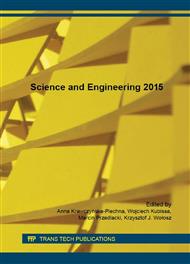[1]
M. Markowski and K. Urbaniec, Optimal cleaning schedule for heat exchangers in a heat exchanger network, Appl. Therm. Eng., vol. 25, no. 7, p.1019–1032, (2005).
DOI: 10.1016/j.applthermaleng.2004.06.025
Google Scholar
[2]
S. Macchietto, G. F. Hewitt, F. Coletti, B. D. Crittenden, D. R. Dugwell, A. Galindo, G. Jackson, R. Kandiyoti, S. G. Kazarian, P. F. Luckham, O. K. Matar, M. Millan-Agorio, E. A. Müller, W. Paterson, S. J. Pugh, S. M. Richardson, and D. I. Wilson, Fouling in Crude Oil Preheat Trains: A Systematic Solution to an Old Problem, Heat Transf. Eng., vol. 32, no. 3–4, p.197–215, (2011).
DOI: 10.1080/01457632.2010.495579
Google Scholar
[3]
J. Wernik and K. J. Wolosz, Numerical Simulations and Research of Heat Transfer in Pneumatic Pulsator, Int. J. Nonlinear Sci. Numer. Simul., vol. 16, no. 3–4, (2015).
DOI: 10.1515/ijnsns-2014-0012
Google Scholar
[4]
Q. Wang, G. Chen, Q. Chen, and M. Zeng, Review of Improvements on Shell-and-Tube Heat Exchangers With Helical Baffles, Heat Transf. Eng., vol. 31, no. 10, p.836–853, (2010).
DOI: 10.1080/01457630903547602
Google Scholar
[5]
J. -F. Yang, M. Zeng, and Q. -W. Wang, Effects of sealing strips on shell-side flow and heat transfer performance of a heat exchanger with helical baffles, Appl. Therm. Eng., vol. 64, no. 1–2, p.117–128, (2014).
DOI: 10.1016/j.applthermaleng.2013.11.064
Google Scholar
[6]
K. Brodowicz and M. Markowski, Calculation of heat exchanger networks for limiting fouling effects in the petrochemical industry, Appl. Therm. Eng., vol. 23, no. 17, p.2241–2253, (2003).
DOI: 10.1016/s1359-4311(03)00190-x
Google Scholar
[7]
J. Nesta and C. A. Bennett, Fouling mitigation by design, Proc ECI Conf Heat Exch. Fouling Clean. – Chall. Oppor., vol. Germany: Kloster Irsee, June 5–10, RP2, no. 49, p.342–347, (2005).
Google Scholar
[8]
M. A. S. S. Ravagnani and J. A. Caballero, Optimal heat exchanger network synthesis with the detailed heat transfer equipment design, Comput. Chem. Eng., vol. 31, no. 11, p.1432–1448, (2007).
DOI: 10.1016/j.compchemeng.2006.12.005
Google Scholar
[9]
M. Pan, I. Bulatov, and R. Smith, Exploiting Tube Inserts to Intensify Heat Transfer for the Retrofit of Heat Exchanger Networks Considering Fouling Mitigation, Ind. Eng. Chem. Res., vol. 52, no. 8, p.2925–2943, (2013).
DOI: 10.1021/ie303020m
Google Scholar
[10]
R. Goedecke, P. Drögemüller, W. Augustin, and S. Scholl, Experiments on Integral and Local Crystallization Fouling Resistances in a Double-Pipe Heat Exchanger With Wire Matrix Inserts, Heat Transf. Eng., vol. 37, no. 1, p.24–31, (2016).
DOI: 10.1080/01457632.2015.1025005
Google Scholar
[11]
M. C. Georgiadis and L. G. Papageorgiou, Optimal energy and cleaning management in heat exchanger networks under fouling, Chem. Eng. Res. Des., vol. 78, no. 2, p.168–179, (2000).
DOI: 10.1205/026387600527194
Google Scholar
[12]
H. Müller-Steinhagen, M. R. Malayeri, and A. P. Watkinson, Heat Exchanger Fouling: Mitigation and Cleaning Strategies, Heat Transf. Eng., vol. 32, no. 3–4, p.189–196, (2011).
DOI: 10.1080/01457632.2010.503108
Google Scholar
[13]
F. S. Liporace and S. G. D. Oliveira, Real Time Fouling Diagnosis and Heat Exchanger Performance, Heat Transf. Eng., vol. 28, no. 3, p.193–201, (2007).
DOI: 10.1080/01457630601064595
Google Scholar
[14]
E. M. Ishiyama and S. J. Pugh, Considering In-Tube Crude Oil Boiling in Assessing Performance of Preheat Trains Subject to Fouling, Heat Transf. Eng., vol. 36, no. 7–8, p.632–641, (2015).
DOI: 10.1080/01457632.2015.954916
Google Scholar
[15]
M. Markowski, M. Trafczynski, and K. Urbaniec, Validation of the method for determination of the thermal resistance of fouling in shell and tube heat exchangers, Energy Convers. Manag., vol. 76, no. 0, p.307–313, (2013).
DOI: 10.1016/j.enconman.2013.07.052
Google Scholar
[16]
M. Markowski, M. Trafczynski, and K. Urbaniec, Identification of the influence of fouling on the heat recovery in a network of shell and tube heat exchangers, Appl. Energy, vol. 102, p.755–764, (2013).
DOI: 10.1016/j.apenergy.2012.08.038
Google Scholar
[17]
E. M. Ishiyama, W. R. Paterson, and D. Ian Wilson, Optimum cleaning cycles for heat transfer equipment undergoing fouling and ageing, Chem. Eng. Sci., vol. 66, no. 4, p.604–612, (2011).
DOI: 10.1016/j.ces.2010.10.036
Google Scholar
[18]
B. C. G. Assis, J. C. Lemos, E. M. Queiroz, F. L. P. Pessoa, F. S. Liporace, S. G. Oliveira, and A. L. H. Costa, Optimal allocation of cleanings in heat exchanger networks, Appl. Therm. Eng., vol. 58, no. 1–2, p.605–614, (2013).
DOI: 10.1016/j.applthermaleng.2013.04.043
Google Scholar
[19]
J. Aminian and S. Shahhosseini, Evaluation of ANN modeling for prediction of crude oil fouling behavior, Appl. Therm. Eng., vol. 28, no. 7, p.668–674, (2008).
DOI: 10.1016/j.applthermaleng.2007.06.022
Google Scholar
[20]
E. I. Varga, K. M. Hangos, and F. Szigeti, Controllability and observability of heat exchanger networks in the time-varying parameter case, Control Eng. Pract., vol. 3, no. 10, p.1409–1419, (1995).
DOI: 10.1016/0967-0661(95)00144-j
Google Scholar
[21]
P. S. Varbanov, J. J. Klemeš, and F. Friedler, Cell-based dynamic heat exchanger models—Direct determination of the cell number and size, Comput. Chem. Eng., vol. 35, no. 5, p.943–948, (2011).
DOI: 10.1016/j.compchemeng.2011.01.033
Google Scholar
[22]
T. Masters, Practical neural network recipes in C++. Morgan Kaufmann, (1993).
Google Scholar
[23]
K. Hornik, M. Stinchcombe, and H. White, Multilayer feedforward networks are universal approximators, Neural Netw., vol. 2, no. 5, p.359–366, (1989).
DOI: 10.1016/0893-6080(89)90020-8
Google Scholar


